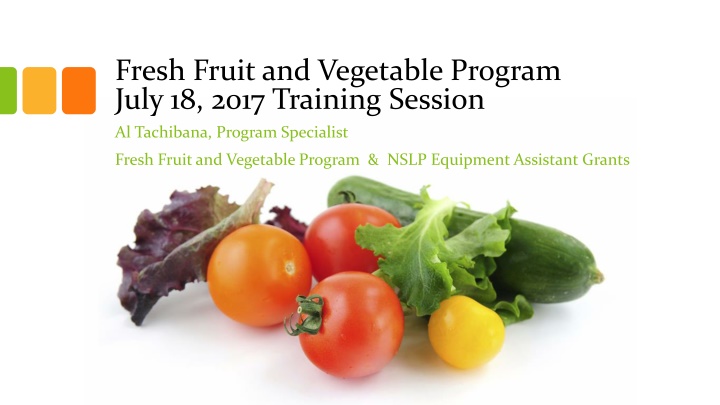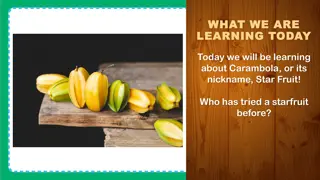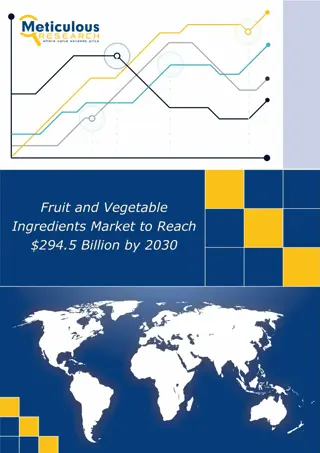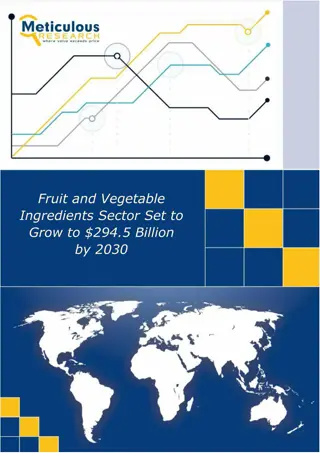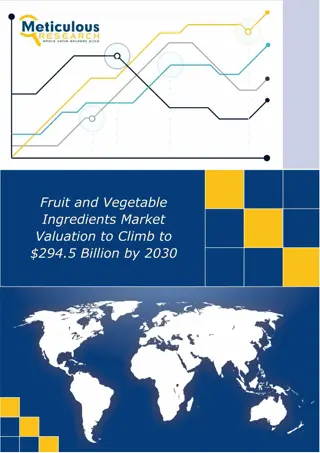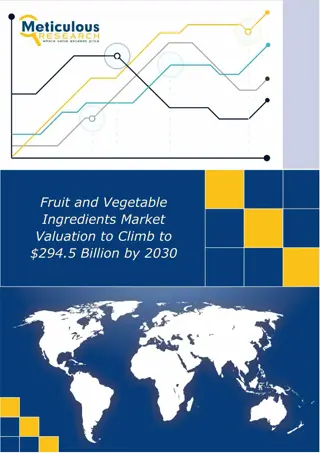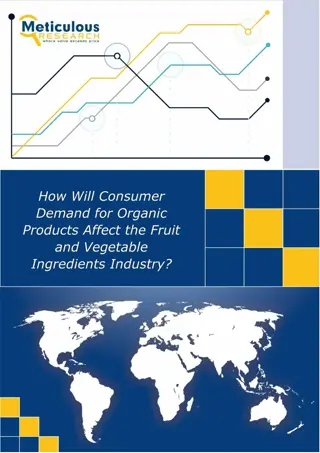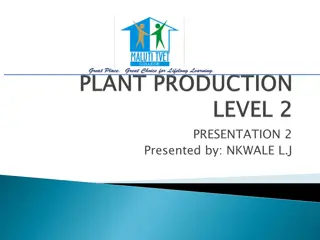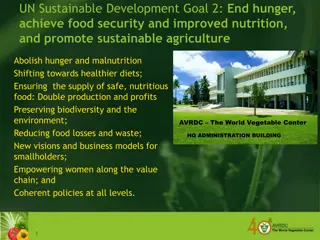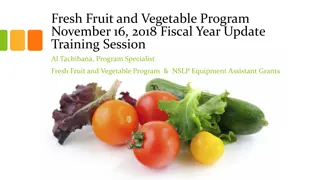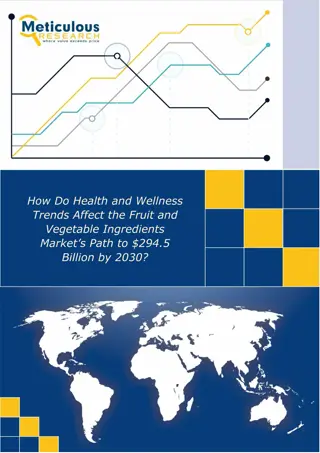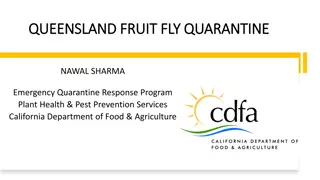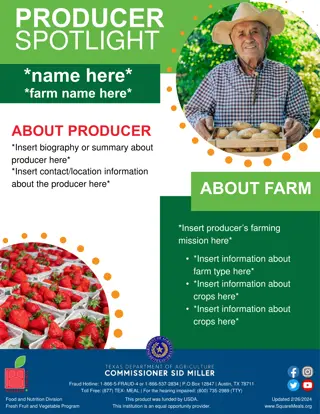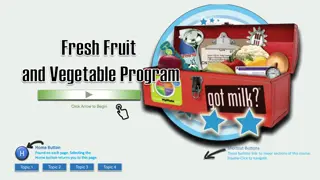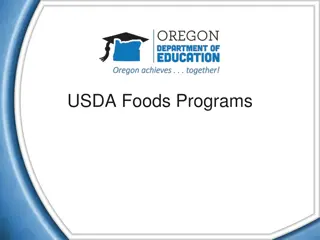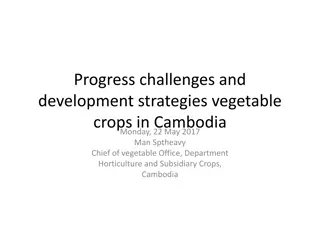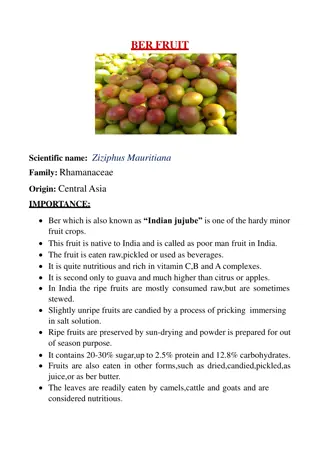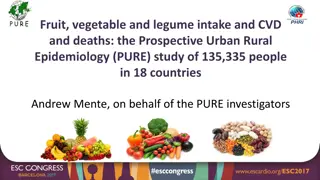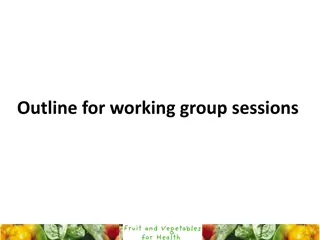Fresh Fruit and Vegetable Program: A Healthier School Environment
This program aims to increase students' consumption of fruits and vegetables, create a healthier school environment, and combat childhood obesity by introducing children to a variety of produce. The USDA Evaluation of FFVP in 2013 showed a significant impact on daily fruit and vegetable intake among participating students, emphasizing the importance of healthy eating habits from a young age.
Download Presentation

Please find below an Image/Link to download the presentation.
The content on the website is provided AS IS for your information and personal use only. It may not be sold, licensed, or shared on other websites without obtaining consent from the author.If you encounter any issues during the download, it is possible that the publisher has removed the file from their server.
You are allowed to download the files provided on this website for personal or commercial use, subject to the condition that they are used lawfully. All files are the property of their respective owners.
The content on the website is provided AS IS for your information and personal use only. It may not be sold, licensed, or shared on other websites without obtaining consent from the author.
E N D
Presentation Transcript
Fresh Fruit and Vegetable Program July 18, 2017 Training Session Al Tachibana, Program Specialist Fresh Fruit and Vegetable Program & NSLP Equipment Assistant Grants
A Brief History of FFVP 2002 FFVP pilot began 4 states / 1 ITO 2004 FFVP permanent program under NSLA Only for 10 states / 2 ITOs 2006 Expanded FFVP to six more states 2008 Nationwide FFVP funding HAWAII began operating FFVP Consolidated Appropriations Act Farm Bill
FFVP GOALS Create a healthier school environment by providing healthy food choices. Expand the variety of produce students consume. Increase students produce consumption. Make a difference in students diets to impact their present and future health.
F&V Riddle: Why did the honeydew jump into the lake?
FFVP is A social equity program that addresses health disparities in our community FFVP is seen as an important catalyst for change in efforts to combat childhood obesity by helping children learn more healthful eating habits. The FFVP introduces school children to a variety of produce that they otherwise might not have had the opportunity to sample. FFVP Handbook, USDA
USDA Evaluation of FFVP March 2013 Impact of FFVP on Daily Fruit and Vegetable Intake Students at schools participating in FFVP consumed 15% more fruits and vegetables 2.39 2.5 2.07 Fruit and vegetable consumption increased by 1/3 cup among students participating in the program, compared to non- participating students 2 Cup-Equivalents 1.5 Increased fruit and vegetable consumption appears to have replaced consumption of other foods 1 Children in low socio-economic status households are more likely to have the lowest intakes of fruits and vegetables (Dubowitz et al., 2008) 0.5 0 FFVP Participating Students Nonparticipating students http://www.fns.usda.gov/ORA/menu/Publi shed/CNP/FILES/FFVP_Summary.pdf
FFVP Usage in Hawaii July 2015-June 2016 claims Any unused funding goes back to the USDA at the end of the year In SY15-16, just 80% of Hawaii s FFVP funds was used In total, approximately $425,000 of available FFVP funds had to be returned to the USDA (incl. HCNP unused admin. funds) For this SY16-17, we are looking at $1 million of FFVP funs returning to USDA FFVP Total Funds Used Compared to Allocated $2,000,000.00 $2,039,062 $1,800,000.00 $1,600,000.00 $1,400,000.00 $1,634,729 $1,200,000.00 $1,000,000.00 $800,000.00 $600,000.00 $400,000.00 $200,000.00 $0.00 Allocated Used
Program Goals Create a healthier school environment Expand variety of fruits & veggies children experience Increase fruit & veggie consumption Make a difference in children s diets to impact their present and future health
From 2012-2013 USDA Report of FFVP Implementation
Possible ways HCNP could help to make FFVP easier. Provide more information on Fresh Fruits & Vegetables (much free materials can be downloaded from USDA Website) Find additional vendors to keep cost down and have more choices (Procurement [proper purchasing of fruits and vegetables] is an ongoing and a growing focus throughout USDA programs) and is part of any program Administrative Review) Provide a video to introduce the program and motivate kids to eat fresh fruits and veggies Provide health and physical education resources and offer professional development opportunities Work with communities partners like FoodCorpsand the Hawaii School Garden Hui (HFSSGH) that can assist schools with their Wellness, FFVP, and Farm to School programs.
Program Objectives Build a strong school-level FFVP team Tie FFVP into school s Wellness Plan Develop effective program Action-Implementation Plan Integrate FFVP into core curriculum Create healthier school community Develop nutrition education Manage budget & claim procedures
School Eligibility Must be a school serving K-6th grade Operate NSLP Submit a yearly application Priority schools have 50% or more of students eligible for free or reduced price meals Committed to fulfilling program objectives
Approved Schools Receive funds based on an allocation of $50 - $75 per student Must submit a correct monthly claim on time and stay within budget 10% administrative (DOE schools 7%) for planning, paperwork, nutrition education planning, not prep/service Up to 20% for program operating costs to include salary and fringe benefits for employees who wash, prep, distribute and serve food
Handbook Highlights FFVP encourages (pg. 8) Schools to make every effort to provide fresh fruits and vegetables a minimum of twice a week as repeated exposure to new foods is a key to acceptance A variety of implementation strategies Complementary nutrition education Schools should develop guidelines to remind children of good manners when they receive and eat their fruit and vegetable snacks, and to dispose their trash (pg. 13)
Marketing and Promotion No funds available for promotional activities Lots of resources on the internet Invite community partners and local resources to assist Engage the entire school community and integrate FFVP into all of your school programs and special events
Nutrition Education Make nutrition education a priority in Wellness Policy and school s Academic and Financial Plan Integrate nutrition education into core subjects: language arts, math, art, science Consider planting a school garden
School Environment Create FFVP bulletin board, posters Create a snack, celebration, fundraising policy consistent with Wellness Guidelines Invite local chefs to participate in food demonstrations Use vendors as resources Have parent-child cooking classes Develop a year-round theme: Eat a Rainbow Each week a different color Seasons/Holidays/Cultures Each month
FFVP and the Wellness Policy FFVP guidelines support efforts of school s Wellness Policy
5 Steps Towards Creating a Healthier School 1. Get Local Support To access local resources, banners, brochures, flyers, posters, speakers, training and funding opportunities, register to become a Hawaii 5210 school at http://www.hawaii5210.com
Mahalo! Contact Information Al Tachibana Fresh Fruit & Vegetable Program 650 Iwilei Road, Suite 270 Honolulu, HI 96817 Alvin_Tachibana@notes.k12.hi.us Office: 808-587-3600
